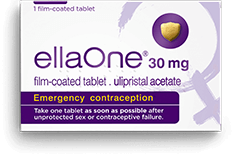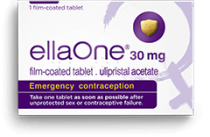How much do you think you know about your menstrual cycle? In a survey conducted by HRA Pharma in 2021, 85% said they felt they understood their menstrual cycle ‘very well’ or ‘pretty well’.
In the same survey, 69% said they believe every day of your cycle carries some risk of pregnancy. We’ve had a lot of comments about this over the years from people who say this is wrong, and that there is only a window of about 5 days in which you can get pregnant. This is a really important topic and we want to make sure you have access to the information you need to make informed decisions.
What happens during the menstrual cycle?
Let’s have a quick overview of the menstrual cycle.
- There’s the menstrual phase which is when your uterus will shed its lining if fertilisation hasn’t occurred. This results in what appears to be bleeding but is actually a mixture of blood and the shed uterine lining (which is also known as the endometrium). This is your period.Day 1 of your period is day 1 of the whole cycle, and if you do get pregnant, the first day of your last menstrual period will be recorded as the first day of your pregnancy until a dating scan adjusts this (more on that later).
- The follicular phase follows your period and is the point when your body releases follicle stimulating hormones to encourage ovulation. Your ovaries produce follicles (around 10, though this will vary) containing immature eggs which mature over the course of this phase until just one of them is ready to be released during ovulation.
- Ovulation is when an egg is released into the fallopian tubes and can be fertilised if sperm is present. If it is fertilised, it could implant in the uterus and become an embryo. Otherwise, it will be shed with the endometrium during menstruation.
- Once you’ve ovulated, the luteal phase occurs. Hormones including progesterone and oestrogen rise in preparation for pregnancy and decrease if pregnancy does not occur, followed by the whole thing kicking off again with a period.
What is a ‘normal’ menstrual cycle?
During a 28 day menstrual cycle, ovulation will likely occur roughly 14 days before the beginning of the next cycle – the first day of your next period. You might still ovulate 2 weeks before your period if you have a longer or shorter cycle (so if you had a 35-day cycle it could happen around day 21, for instance), but this can vary from person to person and from cycle to cycle. There are various factors such as stress, changing time zones, hormonal fluctuations and diet which can affect when and if you ovulate.
You may think that most people have a 28 day cycle, but anything from 21 to 40 days is considered normal. If you have any concerns about your menstrual cycle and fertility, it may be worth discussing with your GP
Following ovulation, the egg is present in the fallopian tube and ready to be fertilised for around 12 to 24 hours. That 5-day window? That’s the 5 days leading up to ovulation. Sperm can survive inside the body for up to 5 days. If you have sex during those 5 days and there is sperm present in your body when you ovulate, there’s a chance that you could get pregnant. Depending on your cycle, this means that even if you had unprotected sex on your period, there’s a chance you could ovulate whilst the sperm is still in your body.
So yes, there is indeed a 5-day window where you are most likely to conceive if you have unprotected sex or experience contraceptive failure!
So why do we say that every day of your cycle carries some risk of pregnancy?
The existence of a 5-day fertile period doesn’t mean that there’s no truth to the idea that every day carries some risk. It all depends on your very own unique cycle, how your body does things and how aware you are of what is happening on any given day.
“There are days during your cycle when you are fertile and days when you are not. The difficulty is knowing which days those are. Our hormones and therefore our menstrual cycle can be affected by a number of factors making our fertility unpredictable,” says Deborah Evans, a pharmacist with over 35 years of experience.*
*Deborah Evans does not endorse any products or brands.
“It’s not just a case of when the egg is released at ovulation but how long the sperm are viable and present to cause fertilisation; this can span a number of days,” says Deborah. “Knowing when we are fertile assumes that we’re like clockwork; some people are, but a lot of people are not.”
Not every cycle is 28 days long. Even if yours is, the different phases of your cycle (before, during, and after ovulation) can vary in length. It’s really hard to pinpoint the exact time of ovulation and it could vary no matter how regularly your period shows up. There are many reasons this could happen – including changes to your sleep pattern, stress, travel or diet – and sometimes it can just fluctuate for no identifiable reason at all.
Some people don’t find out just how irregular their 28-day cycle can be until they do get pregnant and their first ultrasound scan shows that they are a week (or maybe even more) behind what they had expected based on their last menstrual period. This could mean that they got pregnant when they didn’t think they were ovulating.
How can you find out when you’re ovulating?
Calculating when you’re ovulating is not an exact science, particularly at first when you aren’t overly familiar with the signals your body gives you. It can be more useful when you are trying to get pregnant and need to work out when your best chance of success is. Some people do this by tracking their basal body temperature (BBT), cervical mucus or by using ovulation predictor kits (test strips that seek out luteinizing hormones in your urine).
Basal body temperature tracking involves consistently taking your temperature at the same time each morning using a special thermometer that measures temperatures in very small increments and looking to see when it peaks each month. This can signify that ovulation has occurred.
Tracking by checking cervical mucus involves keeping a close eye on what type of discharge your body is producing. During ovulation it will likely be a thick, clear mucus, often referred to as “egg white cervical mucus.” It can also help to be mindful of what your body tends to do before and after ovulation as well.
These methods of fertility tracking might not be foolproof every time, but the main thing is that if you are not certain of when you are ovulating or have ovulated, there is a risk of pregnancy.
Speak to a GP or pharmacist to find out more about the menstrual cycle and how to be sure about when you’ve ovulated.
How does the morning after pill work?
It’s really hard to be clear on the exact point of ovulation even if you’re spending hours every day tracking absolutely everything. The morning after pill works by delaying ovulation, postponing release of the egg so any sperm which are waiting around will die before you ovulate.
The morning after pill solely works by delaying ovulation, so if you have already ovulated it won’t be effective. This is why it’s a good idea to take the morning after pill as soon as possible, so that you have less chance to ovulate before taking it.
ellaOne is the most trusted morning after pill* and can help you to avoid unplanned pregnancy.
*Based on sales data. Verify at ellaone.co.uk/verify
Have you ever taken the morning after pill? Why not share your experience below and help us break the stigma which surrounds emergency contraception.
ellaOne® film-coated tablet for emergency contraception. Contains ulipristal acetate. Always read the label.




